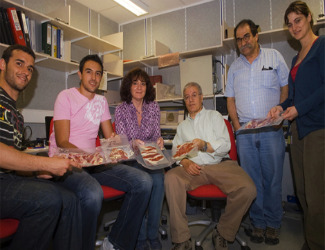Identifying different types of hams with synchrotron light

Identifying hams originating from free roaming pigs fed on acorns, aged correctly and cured for two or more years is not an easy task. Methods used to imitate these conditions are becoming more sophisticated and there are few clues as to how to prove scientifically the product's authenticity. For this reason, biomarkers used until now such as vitamin E to verify whether the pig was free roaming or housed, or fatty acid relations to determine if it was fed acorns or other products, have become obsolete since they can be imitated with the right pig feeds. Manuel Valiente, researcher at the Department of Chemistry at Universitat Autònoma de Barcelona and native of the Jabugo region, famous for its hams, currently directs a project aimed at identifying new biomarkers.
During an experiment carried out in the European synchrotron ESRF, Valiente spoke with Germán Castro, head of the Spanish experimental station SpLine, to propose the idea of using synchrotron X-rays (spectroscopy techniques) to obtain information on how components changed throughout the curing process with the aim of determining quality and origin, such as where the pig was bred and fed and the length of the curing process. These changes, which affect the evolution in the ham's colour, could be used as biomarkers for the final product. The first tests were carried out in the month of March, which is when researchers realised that synchrotron light could reveal details which previously could not have been observed.
Metallic compounds present in pork proteins, especially those containing iron and zinc, possibly are the elements that dictate changes in colour during the ham's curing process. It is well known that during the process, which normally takes from one to two years, there is an exchange between iron and zinc, which are mainly found in proteins such as myoglobin and porphyrin compounds.
The research team has studied 20 different samples of ham from different years and coming from both housed and free roaming pigs (in holm oak fields of Valdelarco, Huelva), as well as samples of Italian hams from the regions of Parma and San Daniele. Researchers used the SpLine facilities during the four days of experiments.
Preliminary results point to the presence of ten different metals in the samples studied. "We were surprised at the variety of metals found and of their quantitative relation", Valiente explains. "This indicates that zinc and iron might not be the only metals in ham to undergo modifications", he adds. At present, the data compiled is being analysed in detail, including its correlation with the hyperspectral imaging technique developed by Dr Giuseppe Bonifaci's group from Spaienza University of Rome and which is being applied to the samples analysed at the synchrotron.
This experiment will serve to identify more sensitive parameters needed to reach the objectives proposed by researchers and develop a more exhaustive study in which the spectroscopic techniques now applied will take on a leading role.


